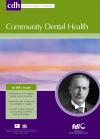Community Dental Health

- Cover Date:
- September 2009
- Print ISSN:
- 0265 539X
- Vol:
- 26
- Issue:
- 3
Opportunities and challenges to promoting oral health in primary schools
Inequalities in oral health in areas of socio-economic disadvantage are well recognised. As children spend a considerable proportion of their lives in education, schools can play a significant role in promoting children’s health and oral health. However, to what extent schools are able to do this is unclear. The aim of this study was therefore to investigate opportunities and challenges to promoting oral health in primary schools. Methods A purposive sample of 20 primary schools from socially and economically disadvantaged areas of Cardiff, UK were selected to participate in this qualitative study. Data were collected through semi-structured interviews conducted with head teachers or their nominated deputies. Results General awareness of health and oral health was good, with all schools promoting the consumption of fruit, water and milk and discouraging products such as carbonated drinks and confectionaries. Health promotion schemes were implemented primarily to improve the health of the children, although schools felt they also offered the potential to improve classroom behaviour and attendance. However, oral health was viewed as a separate entity to general health and perceived to be inadequately promoted. Successful health promotion schemes were also influenced by the attitudes of headteachers. Most schools had no or limited links with local dental services and, or oral health educators, although such input, when it occurred, was welcomed and highly valued. Knowledge of how to handle dental emergencies was limited and only two schools operated toothbrushing schemes, although all expressed an interest in such programmes. Conclusion This study identified a positive predisposition to promoting health in primary schools. The challenge for the dental team, however, is to promote and integrate oral health into mainstream health promotion activities in schools. The paper also makes recommendations for further research.
Key words: Children, deprivation, healthy eating, health promotion, inequalities, oral health, schools.
- Article Price
- £15.00
- Institution Article Price
- £
- Page Start
- 188
- Page End
- 192
- Authors
- P. Gill, I.G. Chestnutt, D. Channing
Articles from this issue
- Title
- Pg. Start
- Pg. End
- The fractional urinary fluoride excretion of adults consuming naturally and artificially fluoridated water and the influence of water hardness: A randomized trial.
- 132
- 137
- The prevalence and severity of dental fluorosis in the high and low altitude parts of Central Plateau, Nigeria
- 138
- 142
- Prevalence of enamel defects related to pre-, peri- and postnatal factors in a Brazilian population.
- 143
- 149
- Development of a psychometric scale to assess satisfaction with dental care among Sri Lankans
- 150
- 156
- Consent of older children participating in BASCD coordinated dental epidemiology surveys in Wales.
- 157
- 161
- A comparison of Personal Dental Service (PDS) and General Dental Service (GDS) patients in terms of reported interventions, oral health and dentists’ perceptions
- 170
- 176
- Hopelessness, depression and oral health concerns reported by community dwelling older Australians
- 177
- 182
- Higher-order exploratory factor analysis of the Dental Subscale of Children’s Fear Survey Schedule in a Taiwanese population.
- 183
- 187
